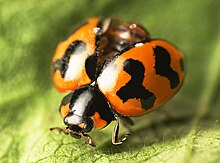Coccinella is the most familiar genus of ladybird (or, in North America, ladybug). The elytra of most species are of a red or orange colour, punctuated with black spots or bands. The genus occurs throughout the Northern Hemisphere, but has only 11 species native to North America, with far more in Eurasia.
| Coccinella | |
|---|---|

| |
| Coccinella transversalis | |
| Scientific classification | |
| Domain: | Eukaryota |
| Kingdom: | Animalia |
| Phylum: | Arthropoda |
| Class: | Insecta |
| Order: | Coleoptera |
| Family: | Coccinellidae |
| Subfamily: | Coccinellinae |
| Genus: | Coccinella Linnaeus, 1758[1] |
| Type species | |
| Coccinella septempunctata Linnaeus, 1758
| |
Its name comes from Latin coccineus, referring to the color scarlet.
Adults and larvae are voracious predators of aphids, and some species (e.g. C. septempunctata) are used as biological control agents.
Selected species
editAccording to the Global Biodiversity Information Facility, 94 individual species of Coccinella are listed in the genus.[2]
- Coccinella californica
- Coccinella hieroglyphica
- Coccinella leonina
- Coccinella novemnotata
- Coccinella magnifica
- Coccinella monticola
- Coccinella prolongata
- Coccinella quinquepunctata
- Coccinella septempunctata
- Coccinella transversalis
- Coccinella transversoguttata
- Coccinella trifasciata
- Coccinella undecimpunctata
Numerous other species, including C. ainu, C. alta, C. difficilis, C. fulgida or C. hasegawai currently have no individual entries here.
References
edit- ^ "ITIS standard report - Coccinella (Linnaeus, 1758)". Integrated Taxonomic Information System. Retrieved 19 July 2014.
- ^ "Coccinella Linnaeus, 1758". Global Biodiversity Information Facility. Retrieved 16 August 2023.
External links
edit